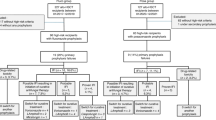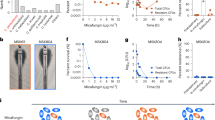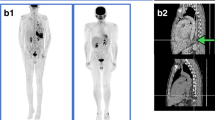Abstract
Invasive fungal infections (IFIs) such as candidiasis and mold infections have caused significant morbidity and mortality among immunocompromised patients in recent years. Micafungin, a new echinocandin, inhibits fungal cell wall β-glucan synthesis, with potent activity against most species of Candida and Aspergillus. The aim of this observational study was to investigate the efficacy and safety of micafungin in prophylaxis of IFIs in 26 high-risk adult patients with various hematological diseases receiving haplo-identical Allo-SCT. Only two patients had a history of possible aspergillosis before transplant treated by voriconazole. The patients received a median of four lines (2–7) of treatment before Allo-SCT. Thirteen patients (50%) received at least one prior Auto-SCT; and eight patients (31%) received a previous Allo-SCT. Patients received a median of 29 infusions (range, 15–85) of micafungin (50 mg/day i.v. as a 1-h infusion). The treatment was initiated at the beginning of the transplant conditioning regimen until the hospital discharge. None of our patients discontinued the treatment for drug-related adverse events. Micafungin was not associated with any hepatotoxicity. Only one patient (4%) discontinued the treatment because of early disease progression. In all patients no Candida and/or Aspergillus species was documented after 3 and 6 months from transplant. None of our patients presented a positive galactomannan antigenemia >0.5. Nine patients (35%) presented a CMV reactivation. Four patients presented an acute GVHD grade II and two patients presented a chronic GVHD. The median follow-up was 11 months (3–23). At the last follow-up, there were 20 patients (77%) who were alive; four patients (12%) died because of disease progression and two patients because of graft failure. Micafungin has a good safety and tolerability profile, with an efficacy in preventing IFI in this high-risk population. Our data provide support for an efficacy study in a prophylaxis setting, but prospective and comparative clinical trials using micafungin are urgently needed to define the role of this drug in prophylaxis after haplo-identical Allo-SCT.
This is a preview of subscription content, access via your institution
Access options
Subscribe to this journal
Receive 12 print issues and online access
$259.00 per year
only $21.58 per issue
Buy this article
- Purchase on SpringerLink
- Instant access to full article PDF
Prices may be subject to local taxes which are calculated during checkout





Similar content being viewed by others
References
Mehta J, Singhal S, Gee AP, Chiang KY, Godder K, Rhee FF et al. Bone marrow transplantation from partially HLA-mismatched family donors for acute leukemia: single-center experience of 201 patients. Bone Marrow Transplant 2004; 33: 389–396.
Aversa F . Haploidentical haematopoietic stem cell transplantation for acute leukaemia in adults: experience in Europe and the United States. Bone Marrow Transplant 2008; 41: 473–481.
Aversa F, Terenzi A, Felicini R, Carotti A, Falcinelli F, Tabilio A et al. Haploidentical stem cell transplantation for acute leukemia. Int J Hematol 2002; 76 (Suppl 1): 165–168.
Aversa F, Velardi A, Tabilio A, Reisner Y, Martelli MF . Haploidentical stem cell transplantation in leukemia. Blood Rev 2001; 15: 111–119.
Aversa F, Reisner Y, Martelli MF . The haploidentical option for high-risk haematological malignancies. Blood Cells Mol Dis 2008; 40: 8–12.
Handgretinger R, Lang P . The history and future prospective of haplo-identical stem cell transplantation. Cytotherapy 2008; 10: 443–451.
Anaissie EJ . Diagnosis and therapy of fungal infection in patients with leukemia—new drugs and immunotherapy. Best Pract Res Clin Haematol 2008; 21: 683–690.
Ascioglu S, Rex JH, de PB, Bennett JE, Bille J, Crokaert F et al. Defining opportunistic invasive fungal infections in immunocompromised patients with cancer and hematopoietic stem cell transplants: an international consensus. Clin Infect Dis 2002; 34: 7–14.
Petraitis V, Petraitiene R, Groll AH, Roussillon K, Hemmings M, Lyman CA et al. Comparative antifungal activities and plasma pharmacokinetics of micafungin (FK463) against disseminated candidiasis and invasive pulmonary aspergillosis in persistently neutropenic rabbits. Antimicrob Agents Chemother 2002; 46: 1857–1869.
Walsh TJ . Echinocandins–an advance in the primary treatment of invasive candidiasis. N Engl J Med 2002; 347: 2070–2072.
Nakai T, Uno J, Otomo K, Ikeda F, Tawara S, Goto T et al. In vitro activity of FK463, a novel lipopeptide antifungal agent, against a variety of clinically important molds. Chemotherapy 2002; 48: 78–81.
Hatano K, Morishita Y, Nakai T, Ikeda F . Antifungal mechanism of FK463 against Candida albicans and Aspergillus fumigatus. J Antibiot (Tokyo) 2002; 55: 219–222.
Denning DW, Marr KA, Lau WM, Facklam DP, Ratanatharathorn V, Becker C et al. Micafungin (FK463), alone or in combination with other systemic antifungal agents, for the treatment of acute invasive aspergillosis. J Infect 2006; 53: 337–349.
Ikeda F, Tanaka S, Ohki H, Matsumoto S, Maki K, Katashima M et al. Role of micafungin in the antifungal armamentarium. Curr Med Chem 2007; 14: 1263–1275.
Niwa T, Shiraga T, Takagi A . Effect of antifungal drugs on cytochrome P450 (CYP) 2C9, CYP2C19, and CYP3A4 activities in human liver microsomes. Biol Pharm Bull 2005; 28: 1805–1808.
Fukuoka N, Imataki O, Ohnishi H, Kitanaka A, Kubota Y, Ishida T et al. Micafungin does not influence the concentration of tacrolimus in patients after allogeneic hematopoietic stem cell transplantation. Transplant Proc 2010; 42: 2725–2730.
van Burik JA, Ratanatharathorn V, Stepan DE, Miller CB, Lipton JH, Vesole DH et al. Micafungin versus fluconazole for prophylaxis against invasive fungal infections during neutropenia in patients undergoing hematopoietic stem cell transplantation. Clin Infect Dis 2004; 39: 1407–1416.
Hashino S, Morita L, Takahata M, Onozawa M, Nakagawa M, Kawamura T et al. Administration of micafungin as prophylactic antifungal therapy in patients undergoing allogeneic stem cell transplantation. Int J Hematol 2008; 87: 91–97.
Hiramatsu Y, Maeda Y, Fujii N, Saito T, Nawa Y, Hara M et al. Use of micafungin versus fluconazole for antifungal prophylaxis in neutropenic patients receiving hematopoietic stem cell transplantation. Int J Hematol 2008; 88: 588–595.
Maertens J, Marchetti O, Herbrecht R, Cornely OA, Fluckiger U, Frere P et al. European guidelines for antifungal management in leukemia and hematopoietic stem cell transplant recipients: summary of the ECIL 3–2009 update. Bone Marrow Transplant 2011; 46: 709–718.
Perfect JR . Management of invasive mycoses in hematology patients: current approaches. Oncology 2004; 18: 5–14.
Aversa F . Full haplotype mismatched hematopoietic stem cell transplants. Haematologica 2002; 87: 9–12.
Martelli MF, Aversa F, Bachar-Lustig E, Velardi A, Reich-Zelicher S, Tabilio A et al. Transplants across human leukocyte antigen barriers. Semin Hematol 2002; 39: 48–56.
Slavin MA, Osborne B, Adams R, Levenstein MJ, Schoch HG, Feldman AR et al. Efficacy and safety of fluconazole prophylaxis for fungal infections after marrow transplantation–a prospective, randomized, double-blind study. J Infect Dis 1995; 171: 1545–1552.
Goodman JL, Winston DJ, Greenfield RA, Chandrasekar PH, Fox B, Kaizer H et al. A controlled trial of fluconazole to prevent fungal infections in patients undergoing bone marrow transplantation. N Engl J Med 1992; 326: 845–851.
Rex JH, Rinaldi MG, Pfaller MA . Resistance of Candida species to fluconazole. Antimicrob Agents Chemother 1995; 39: 1–8.
Slavin MA, Sorrell TC, Marriott D, Thursky KA, Nguyen Q, Ellis DH et al. Candidaemia in adult cancer patients: risks for fluconazole-resistant isolates and death. J Antimicrob Chemother 2010; 65: 1042–1051.
Garnacho-Montero J, Diaz-Martin A, Garcia-Cabrera E, Ruiz Perez de PM, Hernandez-Caballero C, Aznar-Martin J et al. Risk factors for fluconazole-resistant candidemia. Antimicrob Agents Chemother 2010; 54: 3149–3154.
Acknowledgements
We thank the Association pour la Recherche sur le Cancer (ARC) (Pole ARECA) for their generous support of our research. Our group was supported by several grants from the French Ministry of Health as part of the Programme Hospitalier de Recherche Clinique (PHRC). We thank the nursing staff for providing excellent care for our patients and the physicians of the Hematology Department at the Institut Paoli-Calmettes for their important study contributions and dedicated patient care.
Author contributions: JE-C conceived and designed the study, collected and analyzed data, performed statistical analyses, provided clinical care, and wrote and revised the manuscript; GV and RC collected and analyzed data, performed statistical analyses, provided clinical care and revised the manuscript. SF, CF, CO, AG, DC, RB and NV provided clinical care and commented on the manuscript. SD and EF provided pharmaceuticals controls and commented on the manuscript. PBperformed microbiologic monitoring and controls, and commented on the manuscript. CC is in charge of the cell therapy facility that collected and delivered allogeneic blood cell grafts infused into patients included in this analysis, and commented on the manuscript. DB recruited patients, provided clinical care and commented on the manuscript.
Author information
Authors and Affiliations
Corresponding author
Ethics declarations
Competing interests
The authors declare no conflict of interest.
Rights and permissions
About this article
Cite this article
El-Cheikh, J., Venton, G., Crocchiolo, R. et al. Efficacy and safety of micafungin for prophylaxis of invasive fungal infections in patients undergoing haplo-identical hematopoietic SCT. Bone Marrow Transplant 48, 1472–1477 (2013). https://doi.org/10.1038/bmt.2013.87
Received:
Revised:
Accepted:
Published:
Issue date:
DOI: https://doi.org/10.1038/bmt.2013.87
Keywords
This article is cited by
-
Systemic antifungal strategies in allogeneic hematopoietic stem cell recipients hospitalized in french hematology units: a post-hoc analysis of the cross-sectional observational AFHEM study
BMC Infectious Diseases (2022)
-
Micafungin prophylaxis for acute leukemia patients undergoing induction chemotherapy
BMC Cancer (2019)



